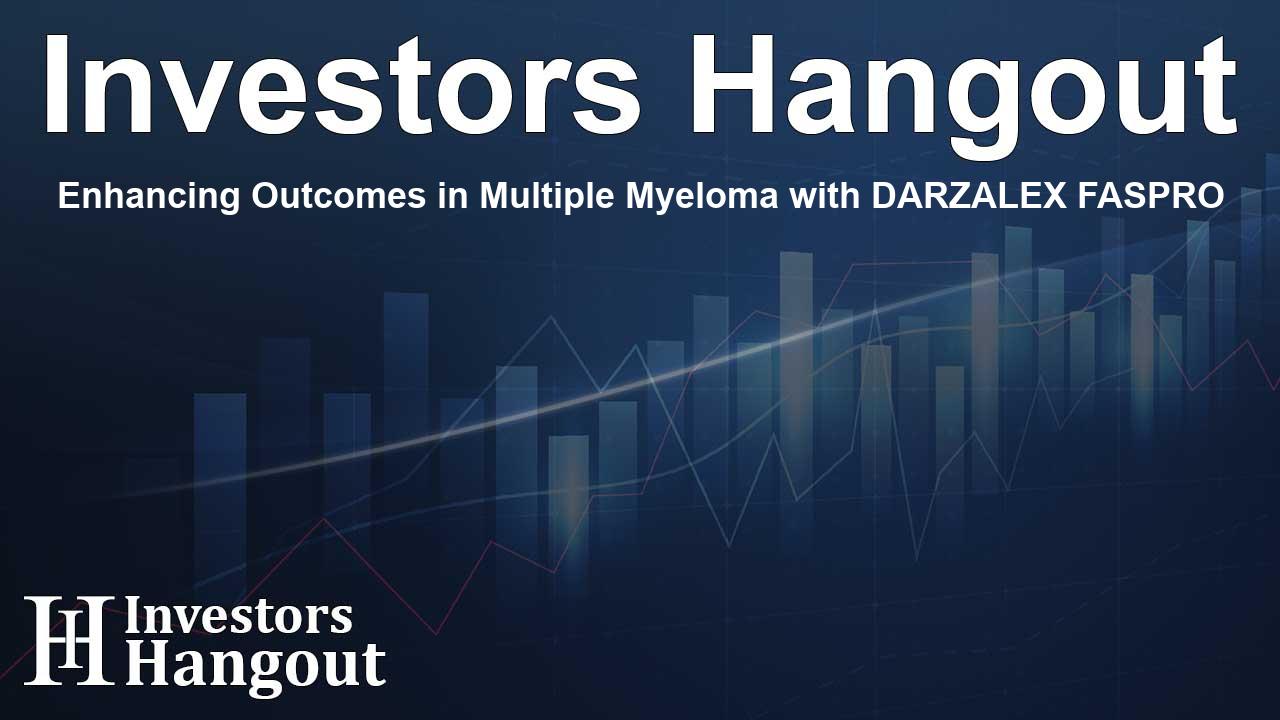Enhancing Outcomes in Multiple Myeloma with DARZALEX FASPRO

Unveiling New Treatment Paths with DARZALEX FASPRO
The latest findings from a comprehensive analysis reveal that regimens based on DARZALEX FASPRO (daratumumab and hyaluronidase-fihj) can greatly enhance treatment outcomes for those battling newly diagnosed multiple myeloma. This revolutionary approach offers hope for patients and healthcare providers alike.
Key Outcomes Highlighted by Recent Studies
In a pivotal Phase 3 CEPHEUS study, an astonishing 85 percent of patients who achieved minimal residual disease (MRD) negativity (?10-6) utilizing DARZALEX FASPRO remained free from disease progression after 4.5 years. Such results underscore the treatment’s efficacy in improving long-term health outcomes.
Furthermore, subgroup analyses from the Phase 3 AURIGA study disclosed enhanced rates of MRD-negative conversion, particularly in populations that have historically faced disproportionate challenges due to multiple myeloma.
The Importance of MRD Negativity
MRD negativity is critically important as it is associated with better overall survival rates and lower risk of relapse. The expanded MRD analysis from the CEPHEUS study showcased the exceptional capability of the DARZALEX FASPRO regimen when combined with bortezomib, lenalidomide, and dexamethasone (D-VRd). This combination demonstrated a remarkable increase in overall and sustained MRD negativity rates compared to VRd alone, paving the way for improved progression-free survival rates.
Data indicated that at 58.7 months of follow-up, a significant portion of the patients receiving D-VRd maintained MRD negativity. Specifically, 60.9 percent of patients achieved MRD negativity at the 10-5 threshold compared to only 39.4 percent in the VRd group, affirming the added benefits of incorporating DARZALEX FASPRO into treatment plans.
Subgroup Insights and Treatment Diversity
The post hoc analysis of the AURIGA study revealed that the addition of DARZALEX FASPRO to the maintenance regimen consistently yielded higher MRD-negative conversion rates, especially in underrepresented patient groups, including older adults and those at advanced disease stages. This underscores the treatment's potential to address the diverse needs of multiple myeloma patients who may not have experienced favorable outcomes with traditional therapies.
Remarkably, in the demographic of patients 65 years and older, those treated with the combined D-R maintenance therapy exhibited a notable MRD-negative rate of 52.6 percent, in stark contrast to 17.5 percent for those receiving lenalidomide alone. Furthermore, Black patients demonstrated an impressive MRD-negative conversion rate of 60.0 percent with the combined therapy.
Comprehensive Analysis and Safety Profiles
The comprehensive analysis of the final Phase 3 ANDROMEDA study further corroborates the positive impact of DARZALEX FASPRO. This particular analysis highlighted significant advancements in overall survival rates for patients diagnosed with light chain amyloidosis (AL), especially when compared to standard regimens.
Patients who received the D-VCd regimen displayed a 56 percent reduction in the risk of disease progression or death, with noteworthy benefits stemming from both hematologic response improvements and enhanced organ protection against deterioration.
Commitment to Patient-Centric Treatment
Healthcare leaders such as Sonja Zweegman, MD, PhD, have emphasized how these findings signify a crucial forward step in treating multiple myeloma patients, particularly for those ineligible for transplant options. The potential for these innovative treatment regimens to positively influence the lives of patients who previously had limited options cannot be overstated.
Moreover, safety profiles for the studies align seamlessly with expectations for DARZALEX FASPRO, suggesting that the treatment maintains an acceptable safety standard while delivering substantial efficacy.
Conclusion and Future Directions
As the landscape of multiple myeloma treatment continues to evolve, DARZALEX FASPRO remains at the forefront, enhancing overall patient outcomes and survival rates. As research progresses, the focus will remain on refining these therapies to maximize their effectiveness across diverse patient populations.
Frequently Asked Questions
What is DARZALEX FASPRO?
DARZALEX FASPRO is a combination treatment that includes daratumumab and hyaluronidase-fihj, aimed at treating multiple myeloma.
How does DARZALEX FASPRO improve MRD negativity?
The treatment enhances overall and sustained MRD negativity rates, significantly contributing to better progression-free survival in patients.
Who benefits the most from DARZALEX FASPRO?
Patients newly diagnosed with multiple myeloma, particularly those ineligible for transplant, benefit significantly from this treatment.
What were the findings from the AURIGA study?
The AURIGA study highlighted higher MRD-negative conversion rates in various patient demographics receiving DARZALEX FASPRO.
What are the future implications of this treatment?
The continual refinement of DARZALEX FASPRO may lead to improved outcomes across a broader range of patients diagnosed with multiple myeloma.
About The Author
Contact Thomas Cooper privately here. Or send an email with ATTN: Thomas Cooper as the subject to contact@investorshangout.com.
About Investors Hangout
Investors Hangout is a leading online stock forum for financial discussion and learning, offering a wide range of free tools and resources. It draws in traders of all levels, who exchange market knowledge, investigate trading tactics, and keep an eye on industry developments in real time. Featuring financial articles, stock message boards, quotes, charts, company profiles, and live news updates. Through cooperative learning and a wealth of informational resources, it helps users from novices creating their first portfolios to experts honing their techniques. Join Investors Hangout today: https://investorshangout.com/
The content of this article is based on factual, publicly available information and does not represent legal, financial, or investment advice. Investors Hangout does not offer financial advice, and the author is not a licensed financial advisor. Consult a qualified advisor before making any financial or investment decisions based on this article. This article should not be considered advice to purchase, sell, or hold any securities or other investments. If any of the material provided here is inaccurate, please contact us for corrections.
